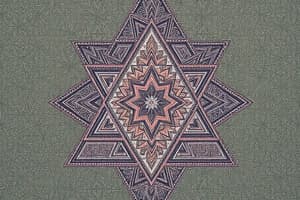Podcast
Questions and Answers
What principle states that correspondences between pairs of angles and sides remain consistent across similar triangles?
What principle states that correspondences between pairs of angles and sides remain consistent across similar triangles?
- Congruency principle
- Proportionality principle (correct)
- Angle sum principle
- Pythagorean theorem
How can we mathematically represent the idea of proportionality between corresponding sides of similar triangles?
How can we mathematically represent the idea of proportionality between corresponding sides of similar triangles?
- $\frac{a}{c} = \frac{b}{d}$ (correct)
- $a \times c = b \times d$
- $a + c = b + d$
- $\frac{a}{b} = \frac{c}{d}$
What essential characteristic is preserved in a dilated image of a similar figure?
What essential characteristic is preserved in a dilated image of a similar figure?
- Shape (correct)
- Perimeter
- Angle measures
- Side lengths
In similar triangles, if the ratio of side lengths is $\frac{5}{8}$, what would be the ratio of their perimeters?
In similar triangles, if the ratio of side lengths is $\frac{5}{8}$, what would be the ratio of their perimeters?
What is the main benefit of understanding similar triangles in geometry problem-solving?
What is the main benefit of understanding similar triangles in geometry problem-solving?
Which property of similar triangles allows for the application of proportion rules from algebra to solve unknown quantities?
Which property of similar triangles allows for the application of proportion rules from algebra to solve unknown quantities?
What does it mean when two figures are considered similar in geometry?
What does it mean when two figures are considered similar in geometry?
What property do corresponding angles of similar triangles possess?
What property do corresponding angles of similar triangles possess?
If the scale factor between two similar triangles is 3, what can be said about their side lengths?
If the scale factor between two similar triangles is 3, what can be said about their side lengths?
In similar triangles, if a : b = 2 : 3, what can be inferred about the ratios of c : d?
In similar triangles, if a : b = 2 : 3, what can be inferred about the ratios of c : d?
What is the main advantage of working with similar triangles in geometry?
What is the main advantage of working with similar triangles in geometry?
If two triangles are similar, what can be said about their corresponding angles?
If two triangles are similar, what can be said about their corresponding angles?
Flashcards
Similarity in Geometry
Similarity in Geometry
Figures are similar when corresponding angles are equal and sides are proportional.
Similar Triangles
Similar Triangles
Triangles are similar when their corresponding sides are proportional by a constant ratio (scale factor).
Scale Factor (k)
Scale Factor (k)
The proportion that governs the scales of similar triangles.
Congruent Corresponding Angles
Congruent Corresponding Angles
Signup and view all the flashcards
Sides Ratios
Sides Ratios
Signup and view all the flashcards
Proportion Property
Proportion Property
Signup and view all the flashcards
Dilations
Dilations
Signup and view all the flashcards
Similar Figure Dilation
Similar Figure Dilation
Signup and view all the flashcards
Study Notes
Exploring Geometry's Hidden Gems: Similar Triangles
In geometry, one particularly fascinating cornerstone is similar triangles—triangular shapes with unique properties that make them indispensable tools for solving problems and understanding geometric relationships. Let's delve deeper into this concept below.
Definition of Similarity and Similar Triangles
When two figures have corresponding angles whose measures are equal and their sides proportional by a constant ratio, we say those figures are similar. This property extends beyond just triangles; it applies to any polygon. For our discussion today, however, we will focus exclusively on similar triangles.
Two triangles are considered similar when each side length of one triangle corresponds to a specific multiple of the side lengths of another triangle. The proportion governing these scales is called the scale factor, often represented as k. When applying this scale factor to all three sides, a triangle remains similar.
 Fig. 1: Two similar right triangles where the scale factor is 2.
Fig. 1: Two similar right triangles where the scale factor is 2.
Properties of Similar Triangles
A significant advantage of dealing with similar triangles lies in their fundamental properties:
- Corresponding angle measurements are always congruent.
- Sides ratios are identical regardless of which pair is compared. In other words, if a : b = c : d, then a : b :: c : d.
These two principles form the backbone of many important geometric concepts and techniques involving similar triangles.
Applications of Similar Triangles
The power of similar triangles becomes apparent through their application in solving various geometric challenges:
Proportion Property of Similar Triangles
This principle states that correspondences between pairs of angles and sides remain consistent across similar triangles, even when those triangles are noncongruent. We can represent this idea mathematically using the formula:
[ \frac{a}{c} = \frac{b}{d}]
As shown above, given the scale factors for the corresponding sides (a over c equaling b over d), we solve for unknown quantities using proportion rules from algebra.
Dilations in Similar Triangles
Dilation transformations change the size and shape of objects while preserving essential characteristics such as relative position and collinearity. A dilated image of a similar figure retains its original shape due to the preserved angle measure equivalence.
Conclusion
Understanding similar triangles provides valuable insights into geometric relationships and opens avenues for problem-solving. These comparable figures serve both to simplify complex configurations and facilitate constructive processes within geometry. With the appropriate knowledge and analytical skills, similar triangles offer opportunities for creative exploration and practical solutions.
Studying That Suits You
Use AI to generate personalized quizzes and flashcards to suit your learning preferences.




